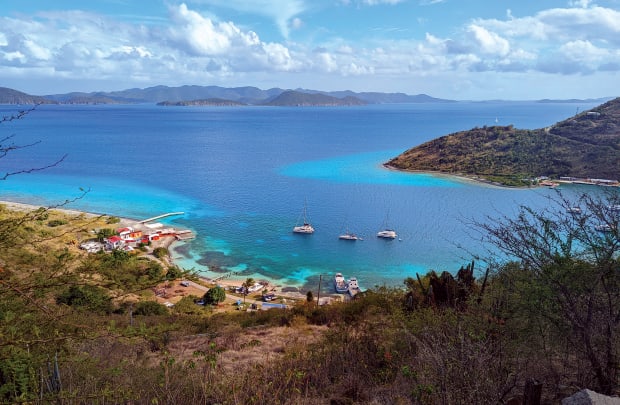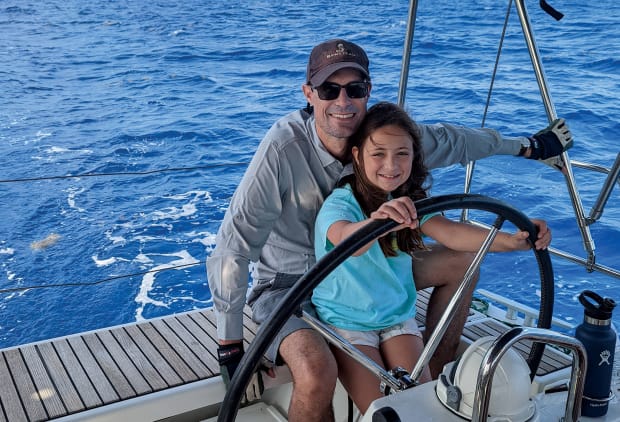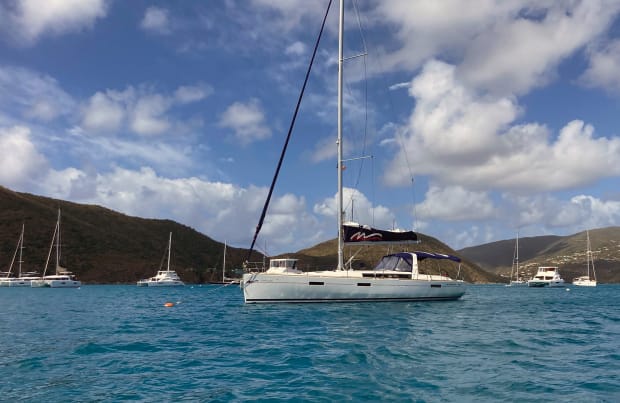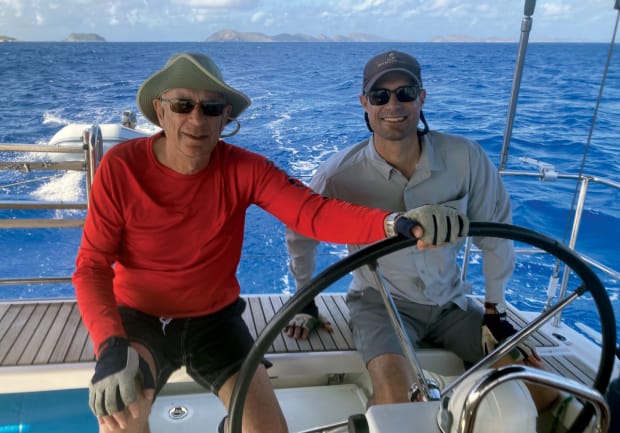
Photo by Ben Rattray
It happens in a moment of weakness. Perhaps my wife is distracted, perhaps she buckles under the gray of the winter sky. Even though Danielle’s idea of a Caribbean vacation features white sandy beaches, a comfortable hotel room, and dinner at a seaside restaurant, she says yes. Two days later I book a sailboat charter in the Caribbean for the spring.
Our son, Owen, grins when I tell him it’s an Oceanis series Beneteau, and our daughter, Avery, jumps up and down and asks whether there will be sea turtles. Daughter Hannah does a ballet twirl, her whole face alight. Then Avery asks, “Will there be sharks?” and shudders, and Danielle says, “We’ll be on the open ocean?”
I try to convince them the sharks are in the deep water away from the islands and that it’s like sailing on the lake—we’ll always be able to see land.
If there ever was a more anticipated vacation, I can’t remember it. Over the next six months, I spend hours at the kitchen table calculating distances between islands, researching anchorages, and routing and rerouting itineraries. I watch Sailing Virgins YouTube videos, re-read John Rousmaniere’s The Annapolis Book of Seamanship, listen to 59 North podcasts, and devour John Kretschmer’s Sailing to the Edge of Time. As the trip draws near, the Amazon deliveries grow exponentially: Sea-Bands, reef-safe sunscreen, UPF shirts, snorkel equipment, duffle bags, and bathing suits. We talk about the trip every night at the dinner table.
Weeks before departure, my daughter and I sail our Beneteau First 285 on the lake (Smith Mountain Lake in Virginia) and practice a new man overboard procedure. She throws a fender off the stern, I run through the steps, and we slip leeward toward the fender until she triumphantly snags it with the boathook. Perfectly done, yet I can’t help but think of how challenging this simple maneuver would be in the ocean if that were my child bobbing in the swells instead of a fender.

Photo by Ben Rattray
Finally, the day before departure arrives, and I am a tangle of nerves as we sit in front of the computer while a proctor watches us insert a swab into each nostril (life during pandemic times). One by one we wait as the reagent decides our fate. Each time the single pink line appears I say a silent prayer of thanks.
Just when I think the worst of the anticipation is over, my phone lights up with a text from the water taxi company. A small craft advisory is in effect for the next day, and they don’t know if they will be able to run the ferry service. There is nothing to do but wait and see if the weather shifts.
Then at 9:30 p.m., the airline sends an email for early check-in, and my youngest daughter, Avery, is not listed on the itinerary. My wife and I try to keep calm while we log into our account, and I listen to a recorded voice tell me how important my call is, and an agent will be right with me. Thirty minutes of frantic clicking later, my wife finds Avery listed separately as an unaccompanied minor.
The next morning—after a two-hour drive to the airport, after an airline agent spends 30 minutes tapping keys to grant us the free bags our airline credit card promises, after they reassign our seats and place my minor children alone, after we take a land taxi across the spine of St. Thomas, after we bounce in a water taxi over impossibly blue water, after we wait for an hour at customs—we arrive at The Moorings charter base. The docks bustle as porters haul luggage, jumpsuit-clad workers lug trash bags, and jet-lagged guests, steeped in anticipation, breathe in the Caribbean air.
A man with a soft face and massive smile piles our duffle bags into the bed of a golf cart.

Photo by Ben Rattray
“I’m Reynaldo. I speak only a little English,” he says as he expertly weaves along the dock, driving over water hoses and around boxes of provisions. “I’m from Dominica.”
I want to ask him about his life on that small island and why he is here now, but I already know the answer—he is here for work, likely separated from his family. We pass two men in polo shirts loading bottles of wine and bags of shrink-wrapped steak onto a boat, and a trio of guests in the cockpit of a massive catamaran sipping glasses of wine. The disparity between workers and guests strikes me hard.
As Reynaldo draws up to the boat, I wonder how this can be real. Tantilizer, a Beneteau-designed Moorings 45.3, lies stern-to the dock, with a wide, double-wheeled transom, dark blue dodger, and beautiful white curves. I step aboard, set my hands on the leather of the port wheel, and look out over the plumb bow. Incredulous, I trace my hand along the lines on each side of the companionway, gaze up the stretch of mast, inspect the cabins, the gimbaled stove, and electronics panel. I open every cupboard and compartment. Back on deck, against rows of catamarans the size of houses and the lilt of rocking masts, the mountains rise, dotted with lights.
Learning the Ropes
The next morning, after an hour-long boat briefing, the dockhands uncleat the lines, and I steer the largest boat I have ever helmed out of the slip. We turn slowly into the channel where a mast protrudes from a sunken vessel, a reminder of the ravages of the 2017 hurricane. Soon we are in the outer channel, the wind whips into us at 26 knots, and the bow pitches in the swell.
Once we are clear of the rocky point, we unfurl a quarter of the genoa and set out on a beam reach. Across the channel, islands that appeared small and well-defined on the charts now stretch out in the distance, hazed and amorphous as they meld into each other.
After years of dreaming, this is it. The wind hits the left side of my face, the sun is bright and clear, and the week stretches before us in all its glory. I have a grin plastered on my face and my body sways in rhythm with the boat.
But as the swells undulate from the east, the boat rolls from gunwale to gunwale, and pallor sweeps over Avery. I try to steer closer to the wind, but the wind, current, and swells move us in a cacophony of motion: swaying, surging, rolling, yawing, pitching, and heaving. My daughter pleads with me to make it stop, and defeated, I haul in the genoa and motor into the wind toward our anchorage.
That night, I sit at the navigation table and trace the 12-nautical-mile route along the chain of islands to our next anchorage. What once seemed like a small distance becomes gargantuan as I think about how quickly Avery grew seasick. My parents have come along with us, and my dad and I plan to sail close to the lee of the islands. I wonder if the trip will be a disaster.
The next morning the wind is a steady 25 knots as we motor out. But we find the swells manageable as we slip along the protection of the islands at 6 to 8 knots with a heavily furled genoa. When we arrive in the North Sound at Virgin Gorda a few hours later, I am triumphant and relieved.
In the evening, with the sun still high over the hills and the water glittering and throwing back the light, I steer the dinghy through the boats on their moorings to the Bitter End dock; Danielle’s hair blows back, and her sundress flutters behind her. We sit in the shade of the open-air, second-story lounge, holding cocktails and looking out over the sound as the boats bob and sway and the breeze falls over us like a kiss. I take in the green of my wife’s eyes and think of all it took for us to be here, in this time, in this place. Of how fortunate I am.

Ben and his dad at the helm.
In the late morning, we set sail for Guana Island. A steady wind plies from the east and the sky is scattered with soft cumulus clouds. I sit at the helm as the north coast of Tortola slips by. Curved bays and beaches give way to the steep rise of verdant mountains, and all around us the sun filters into the deep, clear water and it pulses azure. Three dolphins glide silently off the port side, and suddenly a flying fish careens out of nowhere and skims the surface for so long I wonder if it’s actually a bird.
We sail until the last moment, then furl the genoa and motor into a small bay. Several boats point into a steady wind gusting from the southern point of the island. Across the turquoise water spotted with patches of coral lies a flaxen thread of beach and beyond it scrubby hills with scattered brown lodges.
That afternoon we plunge over the side of the dinghy and kick into the swells heaving around the point. Below, the light sifts through the shallows and rocks cast shadows. Within the reef, angelfish glide through tunnels, parrotfish rack their beaks into outcroppings of coral, and triggerfish scroll by, adorned in a delicate array of colors.
In the evening, I guide the dinghy over to a nearby boat to borrow a can opener. I admire the low freeboard, long canoe stern, and the hallmarks of a long-term cruiser: a windvane fitted to the transom, a yellow Lifesling on the aft railing, and wet clothes clipped to the lifelines. Two people emerge, unhurried, both with deep suntans, probably in their late 30s. The man produces a manual can opener, and as he works it around each can I ask him about his boat name, Tangaroa, the Polynesian god of the ocean. I expect a story of a voyage from the South Pacific, but instead they had made their way from Germany to a boatyard in Belgium, then sailed across the Atlantic and up through the Caribbean. After a nine-month sabbatical, hurricane season is approaching, and they are preparing for the sail back to Europe and work.
That night, I lie in the cockpit with the expanse of stars overhead and listen to the gentle slap of water against the hull and tell myself one day we’ll come back here and sail from island to island without an itinerary or ticket home. We’ll drink a glass of wine while resting on teak seats as the sea changes color in the afternoon light, and we’ll cook together in the early evening at the gimbaled stove as the shape of the land rises and falls through the porthole window, and we’ll sleep months of nights with the sway of the ocean and the creak of the boat. The dreams of the landlocked. My breath melds into the night air. Tangaroa floats a hundred feet away, an aching shard of a beautiful dream.
But we still have more time. We sail farther west around the island, spot a pair of sea turtles from the boat, and at night shine flashlights at tarpon gliding in the inky water, their eyes yellow and ghostlike. We wake to the sharp bleat of goats on the hillside and walk on the floury sand of a national park island.
One day as we beat into the wind, the clouds grow dark and pregnant and a haze meanders in the distance. I am forward running an errant line back through a cleat when it hits, a million divots in a pewter sea, the rain coming down in sheets like a movie set, and I shiver and marvel at the beauty.
Home to Dream
When the last morning arrives, I sip coffee in the silky breeze and watch the sun light up the hills. Then we unfurl the sails for the last time and make our way down the west side of Tortola. At the strait we douse the sails and motor through and then along the south side of the island. I sit on the bow and let the spray froth over me and watch the land go by. Scattered houses perch on the hillsides, a curve of tarmac runs the coastline, and the Road Town harbor approaches.
As the last minutes on the boat drain by, I take stock. I think of motoring across the channel on the first day, of how we hoisted the main only once during the entire week and how the battens snagged the lazyjacks, and the reef lines were sloppy and off kilter. I think of how seasick my daughters were under sail.
I can’t help but dream of setting the sails easily and perfectly, of having an encyclopedic knowledge of sailing like John Kretschmer or John Rousmaniere. But when I think of our sail to the North Sound of Virgin Gorda or our broad reach along the edge of Tortola, the glory of small achievements and victories outshines the failures.
I realize that what is true of marriage and parenting and my work as a physician and of writing is also true of sailing. No matter how much we know, no matter how much wisdom and skill we amass, the conditions will always change, and there will always be more to learn and improve upon. I can compare myself to another boat as it glides by at 12 knots under a flawless main, or I can revel in the beauty of my own misshapen sail and the luminescent blue sky overhead, as both the perfect and imperfect moments layer and imprint, stitching themselves together to form my own memories.
Longing for blue water, Ben Rattray sails his Beneteau 285 on a Virginia lake. He is the author of When All Becomes New, a book of patient stories from neonatal intensive care.
April 2023








